For a long time I've been looking for a picture or something of the Xebec "Cazador". The second planking is in progress, since to think about it. There are models, photos, plans, paintings of all kinds of Xebecs, but obviously none of the "Cazador", apart from the Ocre box. It does not appear on the Spanish ship lists either. Is it maybe a "fantasy" model of Ocre ? Very strange .. Can someone help out, please?
You are using an out of date browser. It may not display this or other websites correctly.
You should upgrade or use an alternative browser.
You should upgrade or use an alternative browser.
based on the information from threedecks, there was one 24 gun spanish Cazador existing, required in 1750For a long time I've been looking for a picture or something of the Xebec "Cazador". The second planking is in progress, since to think about it. There are models, photos, plans, paintings of all kinds of Xebecs, but obviously none of the "Cazador", apart from the Ocre box. It does not appear on the Spanish ship lists either. Is it maybe a "fantasy" model of Ocre ? Very strange .. Can someone help out, please?
Spanish Sixth Rate 'Cazador' (1750)
Spanish Sixth Rate 'Cazador' (1750). Dates of service, name changes, previous and next incarnations, dimensions, armament, commanders, officers and crewmen, actions, battles, sources
threedecks.org
a finished model, well built btw, you can find here:

and also this finished model with more detailed photos

I didn't know threedecks before, thank you for the information. Now I can plank in peacebased on the information from threedecks, there was one 24 gun spanish Cazador existing, required in 1750
but there are not more information available, only that she was build in Cartagena.....Spanish Sixth Rate 'Cazador' (1750)
Spanish Sixth Rate 'Cazador' (1750). Dates of service, name changes, previous and next incarnations, dimensions, armament, commanders, officers and crewmen, actions, battles, sourcesthreedecks.org
a finished model, well built btw, you can find here:

and also this finished model with more detailed photos

You are welcome..... but it says only, that there was a "Cazador" existingI didn't know threedecks before, thank you for the information. Now I can plank in peace
That's OK. The key was "Cartagena". Thanks for that.You are welcome..... but it says only, that there was a "Cazador" existing
On the other hand, also frustration. We spend a lot of time with planking and other time-consuming work, we ultimately have a confirmation of our craftsmanship (or not) to then have to recognize that the ship looked completely different. So we would have to decide between "carpenter" and "painter", between our personal sense of beauty or the approximate historical correctness. But maybe nobody is interested in such "spinning" either.

I think I'll build a model of the early original Algerian Chebeque next, a la Chapman / Mondfeld / Kensington Museum, of course in "museum quality"
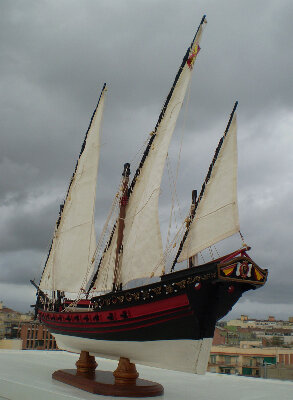
Maybe our friend Ramon alias @ramonolivenza can know much more about these spainsh ships?
Take a look at his Chebeque he finailzed last year
Take a look at his Chebeque he finailzed last year
JABEQUE, TIPO JORGE JUAN [COMPLETED BUILD]
Hace años un amigo mío, modelista, comenzó la construcción de un jabeque conforme a los planos del ingeniero naval español del siglo XVIII Jorge Juan y Santacilia. Mi amigo, abandonó la construcción y me regaló "el pecio". Partiendo de esa base, muchos años despues, comence a continuar ese...
shipsofscale.com
Yes. It was a real ship. In this link you have documentation.
 blog.todoavante.es
blog.todoavante.es
Historia Naval de España. » Jabeque Cazador 1750
CORRECTED: This is one of three designs I have found used for Spanish naval/coast guard-style jabeques. None of the models have excessive ornamentation.
The Ocre model looks like a Jorge Juan hull (one of two designs for which there are plans) with an Algerian-style Xebec upper works and detailing. The last plan below is from the Spanish online Naval archives. They have Xebecs in various gun numbers ranging up to frigate sized xebecs convertible to square-sale. The Spanish never call the big xebecs xebec-frigates, like the English did. It is either a jabeque or a chambequin.
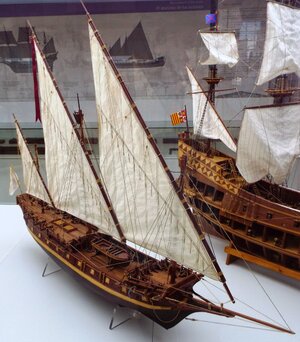
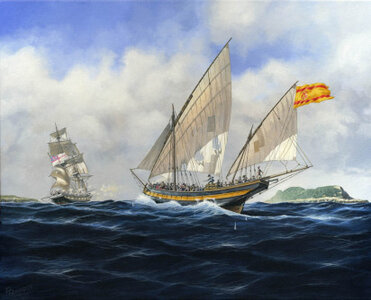
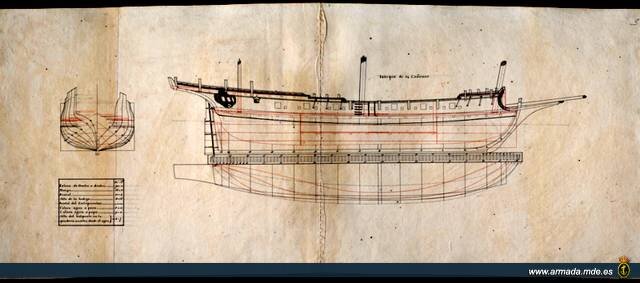
The Ocre model looks like a Jorge Juan hull (one of two designs for which there are plans) with an Algerian-style Xebec upper works and detailing. The last plan below is from the Spanish online Naval archives. They have Xebecs in various gun numbers ranging up to frigate sized xebecs convertible to square-sale. The Spanish never call the big xebecs xebec-frigates, like the English did. It is either a jabeque or a chambequin.



Last edited:
Thank you both for the help. I'm new here and look around, of course I know Ramon's ship, a great job. It shouldn't be about the actual construction, but more about the color. Many of the models that I have seen on the net are more in the direction of the photo. I also have help from REVISTA HISTORIA NAVAL. Año XX. Num. 76 INSTITUTO DE HISTORIA Y CULTURA NAVAL ARMADA ESPAÑOLA. Let's see if I can make sense of it.Yes. It was a real ship. In this link you have documentation.
Historia Naval de España. » Jabeque Cazador 1750
blog.todoavante.es
Of course, every manufacturer simplifies to ensure sales. That's OK too. I bought the kit knowing these things because I would be making changes anyway. Do not want to repeat deviations from the original made over and over again.This is what a Spanish naval/coast guard-style Xebec actually looked like. I do not know about the Ocre model but it looks a lot more like an Algerian-style Xebec than this. It is my impression that Ocre delivers a lot of value, but they do simplify things to make their models easier to make. Algerian style is far more ornate and complicated so they have gone in the opposite direction if it was not from an actual specific plan. The last plan below is from the Spanish online Naval archives. They have Xebecs in various gun numbers ranging up to frigate sized xebecs convertible to square-sale. The Spanish never call the big xebecs xebec-frigates, like the English did.
The biggest mistake from my point of view is the dinghy. It was towed, not brought on board. There is no way to put it into the water. The gun gates lack the "ropes" for opening and closing, Taljenzug in German. But that is often the case with € 600 models. The Algerian Xebec is slimmer, but lies deeper in the water. The ratio of draft to length in the Spanish version is greater. Chapman already shows that, later Moonfield and a model in the Science Museum London. I know the Naval Archives, including the one from Cartagena, where the ship was built. Here at SOS, too, models of excellent craftsmanship are built, which ultimately only have to please the builder. If he wants to paint the ship green blue purple, ok. There is discussion about the color and wood type of the blocks. OK. Was it the same in 1750? Probably not because they had to be imported. There was no longer a usable tree around the Mediterranean. Still, it's okay, of course. Just not halfway historically correct. But that's what I want if possible
Hi Manni, if you are building Occre’s Cazador- hope you have looked into Dean62’s build log of that kit? Very fine example and could give you ideas or aid in building...
Of course, it was the first model of a Xebec that I saw here at SOS. Great and well documented work. A little different from the model I'm working on, however. I bought the same box cheaply because I will "rebuild" the model more in the direction of the original. Lots of little things, except for the dinghy. I have visited and asked dozens of museums and institutes, but no one could explain to me what the boat is supposed to do on deck and how it gets into the water. There are a lot of paintings and graphics that show the actual facts: the boat was towed, like all dinghies of the time. This is also the case with Mondfeld. I suspect that almost all models of the Cazador or other Xebecs are built incorrectly.Hi Manni, if you are building Occre’s Cazador- hope you have looked into Dean62’s build log of that kit? Very fine example and could give you ideas or aid in building...
Hallo @MashFor a long time I've been looking for a picture or something of the Xebec "Cazador". The second planking is in progress, since to think about it. There are models, photos, plans, paintings of all kinds of Xebecs, but obviously none of the "Cazador", apart from the Ocre box. It does not appear on the Spanish ship lists either. Is it maybe a "fantasy" model of Ocre ? Very strange .. Can someone help out, please?
we wish you all the BEST and a HAPPY BIRTHDAY

Thank you, very kind 
We can now definitely say Occre's Cazador is in part fantasy. I have seen plans for two kinds of Spanish military jabeque, the one listed in my prior comment and the less ship-like version, also designed by Jorge Juan, shown below. I have not seen plans for San Antonio chambequin. According to the catalog at the Arsenal at Cartegena, as stated in the below book, Cazador was of the general type show below. Presumably the hull depth, gun ports and quarter deck would have been adjusted to meet her specs. It is kind of aggravating that nearly all of the books on Spanish 18th Century warships are either impossible to find or only available by purchase! Very little of what you need for research on Spanish ships is at Google books. Happy Birthday!
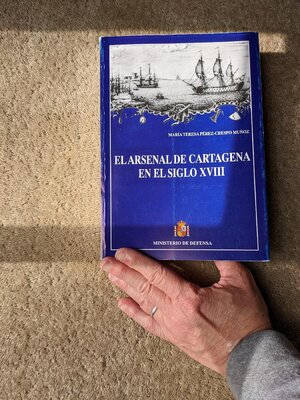
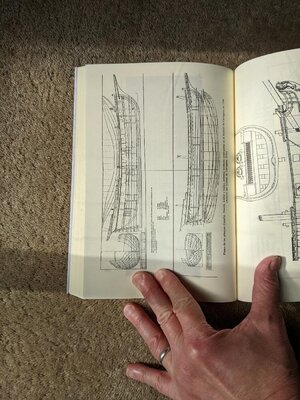


Last edited:
Hello Jeffrey, thank you for the congratulations.
Originally I was only interested in the actual existence of a ship with this name. In February 2021 I found out about the book you showed me in the todoavantes biography list. It was already clear to me that the Ocre model was reduced to a certain type of design. The plans at Mondfeld are also instructive. I would be very interested in building a model based on the original plans. Unfortunately, the Spanish museums and institutes do not respond to any inquiries, you do not even get an answer. A poor behavior. Unfortunately, the book is no longer available, neither in paperback nor in a bound version. Too bad. Now it's up to you to build a realistic model. I envy you this opportunity. Good luck and thanks for the information
Originally I was only interested in the actual existence of a ship with this name. In February 2021 I found out about the book you showed me in the todoavantes biography list. It was already clear to me that the Ocre model was reduced to a certain type of design. The plans at Mondfeld are also instructive. I would be very interested in building a model based on the original plans. Unfortunately, the Spanish museums and institutes do not respond to any inquiries, you do not even get an answer. A poor behavior. Unfortunately, the book is no longer available, neither in paperback nor in a bound version. Too bad. Now it's up to you to build a realistic model. I envy you this opportunity. Good luck and thanks for the information
1) Am reading a translation of the pertinent chapter now but I do not expect more plans for Cazador than what I showed you.
2) No personal interest in Cazador, working on El Gamo xebec-frigate jabeque.
3) SOME Spanish Museums (I am running at about 25%) do reply to me even though they have little that I need. It turns out that my ".net" personal email account was bouncing the replies from the Spanish Naval Museum making me think they were not responding. Wrong; after I repeated the request every week for three weeks one of the staff used his personal email account to send me a message saying to apply with a ".com" address because their response was getting bounced. I am now in the cue Below is a list I was sent years ago of the plans they had pertinent to large jabeques.
2) No personal interest in Cazador, working on El Gamo xebec-frigate jabeque.
3) SOME Spanish Museums (I am running at about 25%) do reply to me even though they have little that I need. It turns out that my ".net" personal email account was bouncing the replies from the Spanish Naval Museum making me think they were not responding. Wrong; after I repeated the request every week for three weeks one of the staff used his personal email account to send me a message saying to apply with a ".com" address because their response was getting bounced. I am now in the cue Below is a list I was sent years ago of the plans they had pertinent to large jabeques.
Attachments
Astonishing! My wishes would have been fulfilled with just one plan. So life is...
As I read the book, it says the type of ship to which Cazador belonged had three sticks with latin candles (yes, that's the translation) and a "jib" The jib is what gets my attention.
Last edited:
What do you mean by "attention" ? Translation ? Jib is the jib boom, in German "Klüverbaum". Can you post the original text ? In context, it usually makes a completely different sense. My Spanish should be enough for that.
On my site you will find the "jib boom". Scroll down, last picture. https://www.wiking-schiffsmodelle.de/Basic/Grundlagen.htm
On my site you will find the "jib boom". Scroll down, last picture. https://www.wiking-schiffsmodelle.de/Basic/Grundlagen.htm
p. 207: "Era un tipo de embarcacion de fino perfil, que podia navegar a vela o a remo. Tenia como he indicado, tres palos con velas latinas y un foque. Este tipo de barco se empleo mucho en las costas mediterraneas contra los ataques de los berberiscos."
"Jib" is a sail, not a boom. The jabeques would henceforth fly both a latin sail and a jib at the foremast!
"Jib" is a sail, not a boom. The jabeques would henceforth fly both a latin sail and a jib at the foremast!




